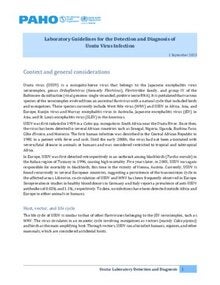Laboratory Guidelines for the Detection and Diagnosis of Usutu Virus Infection

|
Usutu virus (USUV) is a mosquito-borne virus that belongs to the Japanese encephalitis virus serocomplex, genus Orthoflavivirus (formerly Flavivirus), Flaviviridae family, and group IV of the Baltimore classification (viral genome: single-stranded, positive sense RNA). It is postulated that various species of the serocomplex evolved from an ancestral flavivirus with a natural cycle that included birds and mosquitoes. These species currently include West Nile virus (WNV) and USUV in Africa, Asia, and Europe, Kunjin virus and Murray encephalitis virus in Australia, Japanese encephalitis virus (JEV) in Asia, and St. Louis encephalitis virus (SLEV) in the Americas. USUV was first isolated in 1959 in a Culex spp. mosquito in South Africa near the Usutu River. Since then, the virus has been detected in several African countries such as Senegal, Nigeria, Uganda, Burkina Faso, Côte d’Ivoire, and Morocco. The first human infection was described in the Central African Republic in 1981 in a patient with fever and rash. Until the early 2000s, the virus had not been associated with severe/fatal disease in animals or humans and was considered restricted to tropical and subtropical Africa. In Europe, USUV was first detected retrospectively in an outbreak among blackbirds (Turdus merula) in the Italian region of Tuscany in 1996, causing high mortality. Five years later, in 2001, USUV was again responsible for mortality in blackbirds, this time in the vicinity of Vienna, Austria. Currently, USUV is found recurrently in several European countries, suggesting a persistence of the transmission cycle in the affected areas. Likewise, co-circulation of USUV and WNV has been frequently observed in Europe. Seroprevalence studies in healthy blood donors in Germany and Italy report a prevalence of anti-USUV antibodies of 0.02% and 1.1%, respectively. To date, no infections have been detected outside Africa and Europe in either animals or humans.
|
